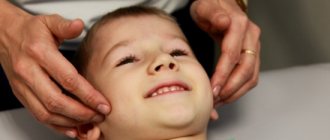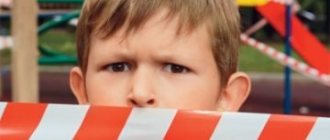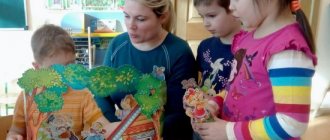Stuttering. Correction of stuttering. article on speech therapy on the topic
Stuttering. Correction of stuttering.
Stuttering is a violation of the tempo-rhythmic organization of speech, caused by the convulsive state of the muscles of the speech apparatus.
The basis of stuttering is the convulsive state of the muscles of the speech apparatus. This condition occurs as a result of disruption of nervous processes. As a result, the transmission of nerve impulses in various parts of the brain is interrupted. When the area of the brain responsible for producing speech is involved in the zone, convulsions occur in various parts of the speech apparatus. Thus, cramps can develop in the muscles of the larynx, pharynx, tongue and palate. The result of these convulsions is the asynchronous firing of speech components - some fire earlier, others later. The vocal cords begin to close tightly and also open, the tempo and fluency of speech is disrupted. Syllables or sounds begin to repeat, pronounced at length and in a whisper, for example, “ppp-field”, “mmma-aaa-tire” and so on. It is noteworthy that the nerve impulses that arise during overexcitation are close in frequency to consonants. That is why stuttering, as a rule, occurs on consonants and much less often on vowels.
Causes of stuttering: Based on existing ideas about the etiology of stuttering, two groups of causes can be distinguished: predisposing and producing. Moreover, some etiological factors can both contribute to the development of stuttering and directly cause it.
Producing causes of stuttering (are not congenital, but acquired as a consequence of serious stress for the body):
- Lesions of the nervous system (disturbances in the body such as brain damage, hypoxia, severe infection cannot but leave a mark on health - their consequence may be deviations in the transmission of nerve impulses from the brain to the speech apparatus);
- Diseases of the sound apparatus (when the organs responsible for sound output are directly affected - the larynx, lips, tongue, etc.);
- Psychological stress (delayed speech development can occur due to severe stress, both long-term and acute short-term).
Predisposing causes of stuttering (a set of factors that carry with them a risk of delay in the development of speech skills):
- characteristics of temperament and minor psychological deviations (a person may begin to stutter due to low resistance to stress or, for example, obsessive fears);
- gender and age (according to statistics, children are much more susceptible to stuttering, and in women it occurs three times less often than in men);
- hereditary diseases transmitted from parents;
- too early, or conversely, too late, the beginning of the development of speech skills in a child;
- learning several foreign languages at once;
- pampering and the habit of distorting words, deliberately pronouncing them incorrectly, imitating and mimicking someone else's speech.
Symptoms of stuttering:
- repetition of sounds, syllables
- stretching sounds and syllables
- pauses (blocks) of silence
The child's speech loses its smoothness and rhythm. The more nervous the child is and tries to overcome the barrier, the more pronounced the stuttering becomes. The facial muscles tense, and tension in the muscles of the limbs is also often observed.
During a conversation, disturbances in facial and articulatory motor skills attract attention. Disorders of coordination of movements of the arms and legs and dynamic praxis are also detected. During a speech therapy examination, the structure of the speech apparatus is normal, but at the same time, articulatory movements are characterized by their limitations and stiffness. Speech is also monotonous and monotonous.
Associated symptoms of stuttering include:
- anxiety;
- anxiety
- motor or vocal tics
- facial muscle tension
The child begins to exhibit avoidant behavior - he tries to avoid situations where he needs to speak out or where a large number of people simply gather. Behavior is characterized by impulsiveness, and the emotional background is characterized by lability.
The main stages of speech therapy work to overcome stuttering.
1. Creation of a protective speech regime.
2. Regulation of emotional and muscular state (relieving muscle and emotional tension). Training in relaxation skills, formulas for inducing a state of relaxation.
3. Development of motor functions. Development of word coordination and rhythmic movement.
4. Formation of phonation (speech) breathing.
5. Work on fluency of speech in its various forms. Development of intonation characteristics of speech.
6. Developing the personality of a child who stutters
An integrated approach to overcoming stuttering.
The full effect in the fight against stuttering can be achieved only if a comprehensive method is used.
Medical influence (drug strengthening of the nervous system and various types of physiotherapy), which helps to normalize the functions of the child’s nervous system and creates a favorable background for psychotherapy, for the active work of a speech therapist.
Psychotherapeutic influence, which is carried out throughout the entire correctional and developmental work.
*Speech therapy rhythm. It consists of a system of various exercises and games with movements accompanied by music or in combination with children’s speech.
*The influence of others on the personality of a stuttering child, on his relationship with the environment and on his emotional-volitional sphere, is carried out throughout the entire period of correctional and educational work.
The modern integrated approach to overcoming stuttering is understood as a therapeutic and pedagogical impact on different aspects of the psychophysical state of a stutterer using different means of correction and the efforts of different specialists. The complex of therapeutic, psychological and pedagogical measures includes medicinal drugs and procedures, physical therapy, psychotherapy, speech therapy classes, speech therapy rhythms, psychological correction classes, and educational activities. Their goal is to eliminate or weaken speech cramps and accompanying disorders of voice, breathing, motor skills and speech; healing and strengthening the nervous system and the entire body as a whole; ridding the child of the wrong attitude towards his speech defect, from psychological layers, re-education of his personality and behavior, social readaptation and adaptation of the stutterer.
The main objectives of the medical and health work carried out by the doctor are: strengthening and improving the nervous system and physical health of the stutterer; elimination and treatment of abnormalities and pathological manifestations in their psychophysical state (weakening or relieving speech cramps, disorders of the autonomic nervous system, motor impairments, etc.).
The main task of correctional pedagogical work, which is mainly carried out by a speech therapist, is the elimination of speech defects (re-education of incorrect speech) and negative personal qualities of people who stutter. The speech therapist organizes the friendly medical and pedagogical work of the necessary specialists (doctors, psychologists, educators, rhythmist, exercise therapy instructor, music worker, etc.), using their methods and means when influencing people who stutter.
Medical and health work. Therapeutic work includes: creating a favorable environment for treatment, organizing a daily routine and balanced nutrition, hardening procedures, physical therapy, drug treatment, physiotherapy and psychotherapy.
- In a specialized institution, it is necessary to create a calm and at the same time cheerful, cheerful mood for a stuttering child; distract his attention from disturbing thoughts about his defect.
- The child must maintain confidence in recovery. Systematic alternation of various types of activities, a certain rhythm of life are also important, as they contribute to the normalization and facilitation of the work of the higher parts of the nervous system and the entire organism as a whole.
- When creating a daily routine, it is important to include sufficient time for rest. To this end, it is necessary for schoolchildren to facilitate the learning process, take breaks more often when doing homework, not overload them with extracurricular and homework, etc.
- A variety of activities is important for children; it arouses their interest. For excitable and active children, activities and games are selected that are calm and quiet. Inhibited children need to be activated and their independence developed.
- In the daily routine of a stuttering preschool child, at least 10–11 hours at night and 2 hours during the day should be allocated for sleep; for schoolchildren, 8–9 hours at night and 1.5–2 hours during the day. Eating should be done no later than 1.5–2 hours before bedtime, otherwise the restoration of the strength of the nerve cells of the cerebral cortex during sleep is less intense. It is necessary to pay attention to fortifying the food of a stuttering child. Vitamins as biological catalysts of all enzyme systems have a beneficial effect on higher nervous activity, reactive forces and the immunological state of the body.
- Tempering procedures are included in the daily routine of a stuttering child. Daily walks, outdoor games, and sports activities strengthen the nervous system and create an emotional uplift. Air baths have an active effect on the cardiovascular system and normalize its functioning.
- Water procedures are important for hardening a child’s body: wiping, dousing, showering and bathing.
- Different types of hardening are prescribed by the doctor strictly individually, depending on the child’s health condition and the characteristics of local climatic conditions.
- Physical therapy and exercise, developing the muscular system, enhance the functioning of the most important vital organs - the lungs and heart, and increase metabolism. They help strengthen the child’s strength and morale, develop coordinated and precise movements, help get rid of stiffness or, conversely, disinhibition of movements, and promote discipline and composure.
- All this is a necessary prerequisite for the better functioning of the speech organs of a stuttering child and has a positive impact on the development of correct speech skills. Physical exercises for children who stutter acquire therapeutic value.
Psychological correction occupies a significant place in the treatment of stuttering. The main goal of psychotherapy is to improve the mental health of a person who stutters:
- education of a full-fledged personality;
- nurturing the correct personal attitude toward one’s own shortcomings and the social environment;
- impact on the micro-social environment.
Corrective pedagogical work with people who stutter
Correctional and educational work is given very important importance in a comprehensive method of overcoming stuttering. The speech therapist occupies a central place in this work. Currently, there are several methods of speech therapy to eliminate stuttering in children. But all of them, one way or another, are subordinate to one goal - to educate children and adults in the ability to speak in normal speech, free from stuttering.
The pedagogical part of the integrated approach is correctional pedagogical (speech therapy) work, which includes a system of speech therapy classes, educational activities, speech therapy rhythm, and work with parents.
Speech therapy work is considered as a system of correctional and pedagogical measures aimed at the harmonious formation of the child’s personality and speech, taking into account the need to overcome or compensate for his defect.
— For the development of all types of speech of stuttering children, games with singing (round dances with dance movements) are of paramount importance. They are held in almost every lesson.
— Further consolidation of the active behavior and speech of stuttering children takes place in the process of outdoor games. In outdoor games, children move with pleasure and speak in rhythm with their movements.
— Outdoor games normalize the motor skills of children who stutter: during the game they have to respond to some signals and refrain from moving during others, combine movements with the rhythm of speech.
— Didactic games are especially useful for children with general speech underdevelopment. Usually, before eliminating stuttering, a speech therapist works to correct sound pronunciation, since sometimes with the correction of incorrect pronunciation, stuttering also disappears.
— Didactic games are followed by games-dramatization of poems, prose, tabletop theater games and creative games (first at the suggestion of an adult, then according to the ideas of the children themselves).
Corrective work on the game system is carried out in several stages.
At the first stage, the teacher-speech therapist examines the state of children’s speech during activities, studies their behavior in games and when performing routine tasks, identifies the personal characteristics of each, corrects breathing, voice, develops the dynamics of the speech apparatus, and draws up an individual and joint work plan with the teacher.
The second stage is the stage of maximum speech restriction. Its goal is to slow down pathological reflexes in children to incorrect speech, accompanying movements and actions, and the use of unnecessary words. This stage includes a period of silence (3-6 days) and a period of whispered speech (10-12 days). During this time, children who stutter develop attention, perseverance, imitation, and general and manual motor skills.
At the third stage (lighter forms of speech), children develop a soft voice, unified pronunciation, expressiveness of speech, and duration of exhalation. At the same time, work is underway to instill voluntary behavior in children who stutter. At this stage, elements of creative games are introduced into classes at the suggestion of the speech therapist. Homework materials include board games, didactic games, outdoor games, and conjugate-reflective recitation of nursery rhymes, poems, excerpts from fairy tales, etc. by children together with their parents.
At the fourth stage, the speech therapist continues to work on correcting the behavior and speech of children who stutter. The selection of games can be very different: games with singing, didactic, active games with rules, dramatization games, creative ones. A prerequisite is the observance of dialogic speech in question-and-answer form in all games.
The goal of the fifth stage is the development of independent speech. The speech therapist teacher creates a large number of game situations in which retellings of a previously prepared text are organically included.
Basic requirements for speech therapy sessions with children who stutter:
- Speech therapy classes implement the main tasks of correctional and pedagogical influence on the speech and personality of a stuttering child.
- Speech therapy classes are conducted in a certain system, sequentially, step by step, taking into account the basic didactic principles; depending on the individual characteristics of each child; based on the consciousness and activity of children. During the classes, manuals, visual and technical teaching aids are used; classes contribute to the strength of the developed skills of correct speech and behavior.
- Speech therapy classes are consistent with the requirements of education and training programs for preschool or school-age children.
- The classes provide for the need to train correct speech and behavior for children who stutter in different conditions - in the speech therapy room and outside it, in different life situations, in the presence of friends and strangers, etc. For this purpose, the whole variety of speech therapy technologies is used: various forms of work on speech development, didactic, active, role-playing and creative games, excursions, preparation and participation in matinees, concerts, performances in front of a microphone.
- Classes are organized in such a way that the child speaks them without stuttering and related disorders.
- Classes keep the child in a good mood, cheerfulness, and self-confidence.
- In classes with people who stutter, there are always examples of correct speech: from the speech therapist himself, successfully engaging children, tape and video recordings of performances by masters of artistic expression, demonstration performances by those who have previously completed a course of speech therapy classes, etc.
- Classes are conducted against the backdrop of the correct attitude of others towards a child who stutters and his correct upbringing. The organization of independent work of a stuttering child is aimed at fulfilling the tasks of a speech therapist in family, living, educational conditions and in a group of peers.
Pros and cons of speech therapy treatment
The effectiveness of speech therapy techniques in the correction of stuttering lies not only in the fact that as a result of classes a person gets rid of a speech defect, but also gains self-confidence.
Speech therapy correction also has a psychotherapeutic effect, since classes include the development of personal qualities.
Speech therapy also affects higher mental functions. Classes for children are structured in such a way that at the same time the development of memory, attention, and thinking occurs.
Each speech therapy method for stuttering correction produces certain results. A negative result in their use can only be recorded if the speech therapist incorrectly diagnosed the degree of development of the defect and made a mistake in selecting the technique.
Main rules of classes
Speech rules for people who stutter:
- Planning a statement. Impromptu speech when stuttering is challenging. At the initial stages of correction, it is better to avoid improvisations in speaking, so as not to provoke speech spasms. When the speaker knows what he wants to say, his psychological stress decreases, and with it the likelihood of a spasm. Preliminary recitation “to yourself” gives a good result.
- Monitor your breathing during the speech act. Speaking while inhaling air is unnatural. You need to pronounce the phrase while exhaling. Moreover, you need to breathe with your diaphragm. The air supply should be spent primarily on pronounced vowel sounds.
- Don't forget about stops in speech. Pauses give you the opportunity to gain air reserves and think about the next phrase. Make pauses not only between meaningful sections of text, but also within long sentences.
- Watch your movements.
General rules of conduct when dealing with stuttering:
Do exercises and other activities to overcome the defect on your own every day. Introducing a daily routine will help with this. Planning for a day will allow you to distribute time so that work on combating stuttering becomes familiar.
Keeping fit
Speech depends on the general physical condition of the body, so it is important to get enough sleep, avoid stressful situations, get proper rest, and eat right. Certain sports help keep the body in good shape, and at the same time train the respiratory system. These include swimming, skiing, walking. Sudden movements and strong muscle tension are contraindicated in logoneurosis, so barbells, boxing, wrestling, jumping, football, and basketball will not be beneficial.
Give up bad habits.
Rules for a speech therapist - when preparing a lesson with children, you must:
- Take into account the leading activity of a particular age. This is a game for preschoolers. All tasks and exercises should be carried out in such a way that the child finds it interesting. Otherwise, you may encounter a reluctance to engage and a loss of contact.
- Monitor the duration of classes. It should be no more than 20 minutes.
- When developing lessons, take into account the individual characteristics of the person who stutters.
- Give material and tasks with a gradual increase in complexity.
Additional checks and studies
Prerequisites for the occurrence of a speech defect can be traumatic brain injuries, intoxication, diseases (hypertrophy, rickets) and severe infections (measles, encephalitis, meningitis, typhus, etc.).
The causes of the disease also include nervous shock and prolonged psycho-emotional stress.
MRI and CT
To identify organic lesions in the central nervous system, MRI and CT are performed.
MRI allows you to diagnose injuries, diseases and tumors that could cause a speech disorder. A CT scan of the brain can detect aneurysms and other pathologies.
Encephalogram (EEG)
An EEG is performed to determine the causes of the disorder and allows to exclude organic lesions of the central nervous system. When studying the results, the doctor determines the location and extent of damage to the central nervous system.
Rheoencephalography
The examination is necessary to identify disorders in the blood vessels of the brain and assess the state of blood circulation. The results of the REG record the degree of blood supply to a certain area, the speed of blood flow and blood viscosity. An examination is carried out for stuttering to identify concomitant diseases.
History taking
The medical history includes the following information:
- health status and presence of speech disorders in parents and immediate relatives;
- analysis of the child’s overall development;
- the presence of diseases in the mother during pregnancy and injuries during childbirth;
- stress and physical trauma in childhood;
- speed of speech formation;
- conditions of upbringing (type of institution and the child’s adaptation to it, learning two or more languages, communication with children who have speech defects);
- psychological climate in the family (conflicts, excessive guardianship, attitude of family members towards the child’s defect);
- the presence of diseases of the organs of vision and hearing.
Lesson methods
Vlasova and Rau developed a system based on gradually more complex exercises. At the first stage, it was supposed to pronounce the learned poems, phrases, and recitation aloud. Collaborative, reflected speech is widely used.
At the second stage, children verbally describe the pictures, based on leading questions, and compose stories based on a series of images. At the third stage, skills are consolidated in everyday activities.
For schoolchildren, other correction methods are used. Their leading activity is educational, lessons are introduced, the teacher and speech therapist influence.
Cheveleva's methods are used, during which children make crafts, pronouncing all the actions. Yastrebova identified three periods of training. On the first, knowledge about the language is clarified, on the second, the development of skills is activated, and on the third, they are consolidated.
A group of specialists (Abeleva, Golubeva, Evgenova and others) created a special technique for adults and adolescents. The correction is accompanied by certain methods of psychotherapy - hypnosis, relaxation techniques and others.
Harutyunyan has developed her own method for correcting stuttering. During it, a person overcomes his defect with the help of his fingers. It synchronizes speech with finger movements. Classes are conducted in small groups of 5 people.
The leading hand is placed on the thigh, fingers pressing on the leg. As each syllable is pronounced, the finger stops pressing on the surface. Hand movements become the controller of the tempo and speed of speech.
The technique includes four stages. At the first stage, the stutterer learns to relax and relieve muscle tension. On the second, finger movements are practiced. The third one trains the pronunciation of words and short phrases. On the fourth, work with the text occurs.
The lack of full psychotherapeutic support is considered a disadvantage of Harutyunyan’s technique. Some experts believe that training cannot greatly correct the defect.
In the correction of stuttering, it is impossible to single out one technique. Each case requires an individual approach from a specialist. The effects of stuttering can last a lifetime.










